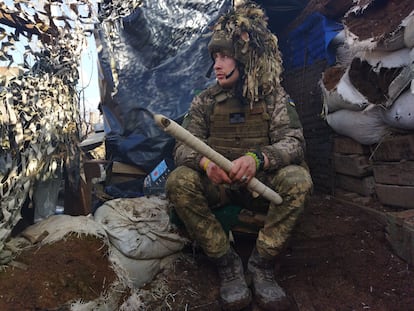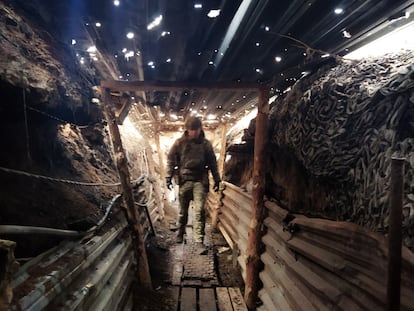Ready for the worst: Life in the trenches of Ukraine’s Donbas region
EL PAÍS visits the frontline of the eight-year conflict between the Ukrainian army and Russian-backed separatists a day before Moscow’s full-blown attack


It was once a thriving mechanical appliance factory in Avdiivka, in Ukraine’s wealthy eastern region. These days, it is an abandoned lot littered with potholes, burnt-out trucks and buildings without roofs. This derelict place opens up onto a Ukrainian army outpost on a 440-kilometer (273-mile) frontline that has become the focus of the world’s attention. A metal projectile sticks out of the ground, as though greeting passersby. Very near this spot, another piece of ammunition has made a hole in the cement, adding to the feeling of being on the set of a post-apocalyptic movie.
“These two mortars are new, 82mm. They were used two days ago,” says Commander Denis. In the background, artillery shots break the silence on this cold and sunny February morning, shortly before Russian President Vladimir Putin’s decision early Thursday to launch a full-blown attack on Ukraine. In the winding trenches of Avdiivka, in the part of the Donetsk area under Ukrainian control – another part is held by pro-Russian separatists whose self-declared “popular republic” was recognized by Putin on Monday – soldiers say they are ready for any scenario. “Every man should be here in these difficult times,” says Oleg, a firefighter who enlisted six months ago.
The Ukrainian government has called up more than 36,000 military reservists with combat experience, according to Oleksiy Danilov, the secretary of the National Security and Defense Council. One of these reservists is Valeriy Kovaliov, who fought in the Donbas region in 2014. In March of that year, Russia annexed the Crimea peninsula and offered military and economic support for separatists in Donbas. A month later, the latter proclaimed independence from Ukraine, triggering a conflict that has dragged out for eight years and claimed more than 14,000 lives.
Kovaliov now thinks that he will soon be returning to the area. “We have to do everything that’s in our power. This is our country, we will not let them steal another piece of it,” he says.

Sitting in the muddy trenches of Avdiivka, 22-year-old Alexéi says he is ready for the worst. Like many other young Ukrainians, he has grown up in the army. He says that attacks launched from the separatist zone, located just a few kilometers from here, have intensified over the past week. Separatists have also been trying to enter Ukrainian-controlled territory in small groups. “I don’t know what Putin’s plan are. What I can imagine is that the Russians will get in, if not this time, then the next,” says Alexéi, who is wearing yellow and blue ribbons – the colors of the Ukrainian flag – on his bulletproof vest.
The Minsk agreements signed in 2015 by Moscow, Kyiv and representatives for the separatists under the aegis of the Organization for Security and Co-operation in Europe (OSCE) never really brought peace to this area, but they did freeze the frontline, which has not moved an inch since then. That is not to say that things have been quiet: in 2017, Avdiivka witnessed the deadliest battle since the peace agreements were signed. It lasted six days and claimed at least 20 lives.
These days, the graffiti on the wall of the old factory – another casualty of a conflict that has destroyed the economic fabric of this former mining and industrial hub – illustrates the soldiers’ mood. There is a childish drawing representing a penis and a message insulting Putin. Another, slightly more polite message reads: “We are happy to receive you in this home if you have been invited. If not, go to hell!”

Nearby, in between the barricades made with car tires and metal sheets, 26-year-old Maxim says he feels safe. “It’s been like this for eight years. Everything can get worse, but a lot of things have already happened during this time. We are ready to defend our country,” he says.
Back in 2014, the Ukrainian army was weak and underfunded, and it was practically taken by surprise when Russia invaded and later annexed Crimea. Its preparedness has since improved, thanks partly to support from Western nations in the form of funds, weapons and training. Even so, the difference remains stark: Russia has around 900,000 troops on active duty compared with Ukraine’s 200,000, to which the reservists have now been added.
Standing under the camouflage nets that cover the roof of one of the observation posts, Oleg, 44, picks up a heavy automatic machine gun as he gets ready for his shift. “This is always dangerous, it’s war, but there’s no choice,” he says. “We are home, in our land.”
Tu suscripción se está usando en otro dispositivo
¿Quieres añadir otro usuario a tu suscripción?
Si continúas leyendo en este dispositivo, no se podrá leer en el otro.
FlechaTu suscripción se está usando en otro dispositivo y solo puedes acceder a EL PAÍS desde un dispositivo a la vez.
Si quieres compartir tu cuenta, cambia tu suscripción a la modalidad Premium, así podrás añadir otro usuario. Cada uno accederá con su propia cuenta de email, lo que os permitirá personalizar vuestra experiencia en EL PAÍS.
¿Tienes una suscripción de empresa? Accede aquí para contratar más cuentas.
En el caso de no saber quién está usando tu cuenta, te recomendamos cambiar tu contraseña aquí.
Si decides continuar compartiendo tu cuenta, este mensaje se mostrará en tu dispositivo y en el de la otra persona que está usando tu cuenta de forma indefinida, afectando a tu experiencia de lectura. Puedes consultar aquí los términos y condiciones de la suscripción digital.










































